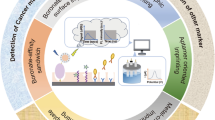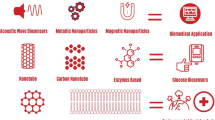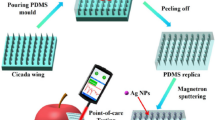Abstract
A rapid and accurate detection of molecular binding of antigen-antibody signaling in high throughput is of great importance for biosensing technology. We proposed a novel optical biochip with multichannels for the purpose of detection of biotin–streptavidin on the basis of localized surface plasmon resonance. The optical biochip was fabricated using photolithography to form the microarrays functioning with multichannels on glass substrate. There are different nanostructures in each microarray. Dry etching and nanosphere lithography techniques were applied to fabricate Ag nanostructures such as hemispheres, nanocylindricals, triangular, and rhombic nanostructures. We demonstrated that 100-nM target molecule (streptavidin) on these optical biochips can be easily detected by a UV-visible spectrometer. It indicated that period and shape of the nanostructures significantly affect the optical performance of the nanostructures with different shapes and geometrical parameters. Our experimental results demonstrated that the optical biochips with the multichannels can detect the target molecule using the microarrays structured with different shapes and periods simultaneously. Batch processing of immunoassay for different biomolecular through the different channels embedded on the same chip can be realized accordingly.








Similar content being viewed by others
Reference
Nakane J, Wiggin M, Marziali A (2004) Biophys J 87(1):615–621. doi:10.1529/biophysj.104.040212
Link S, El-Sayed M (1999) J Phys Chem B 103:8410–8426. doi:10.1021/jp9917648
Kelly KL, Coronado E, Zhao LL, Schatz GC (2003) J Phys Chem B 107:668–677. doi:10.1021/jp026731y
Link S, El-Sayed MA (2003) Annu Rev Phys Chem 54:331–366. doi:10.1146/annurev.physchem.54.011002.103759
Jackson JB, Halas NJ (2001) J Phys Chem B 105:2743–2746. doi:10.1021/jp003868k
Malinsky MD, Kelly KL, Schatz GC, Van Duyne RP (2001) J Am Chem Soc 123:1471–1482. doi:10.1021/ja003312a
Zhu SL, Li F, Luo XG, Du CL, Fu YQ (2008) Sens Actuators B Chem 134:193–198. doi:10.1016/j.snb.2008.04.028
Zhu SL, Li F, Luo XG, Du CL, Fu YQ (2008) Nanomedicine 3:669–677. doi:10.2217/17435889.3.5.669
Haes AJ, Van Duyne RP (2002) J Am Chem Soc 124:10596–10604. doi:10.1021/ja020393x
Haes AJ, Van Duyne RP (2003) Laser Focus World 39:153–156
Riboh JC, Haes AJ, McFarland AD, Yonzon CR, Van Duyne RP (2003) J Phys Chem B 107:1772–1780. doi:10.1021/jp022130v
Haes AJ, Zou S, Schatz GC, Van Duyne RP (2004) J Phys Chem B 108:109–116. doi:10.1021/jp0361327
Kawazumi H, Gobi KV, Ogino K, Maeda H, Miura N (2004) Chem Sens 20(Supplement B):794–795
Jung YJ, Oh MH, Lee SK, Taya M (2005) In: The 13th International Conference on Solid-State Sensors, Actuators and Microsystems, Seoul, Korea, June 5–9, pp 1800–1803
Zhu SL, Li F, Luo XG, Du CL, Fu YQ (2009) Opt Mater 31(6):769–774. doi:10.1016/j.optmat.2008.07.014
Fu Y, Bryan NKA (2005) J Vac Sci Technol B 23:984–989. doi:10.1116/1.1926291
Fu Y, Bryan NKA, Zhou W (2006) J Nanosci Nanotechnol 6:1954–1960. doi:10.1166/jnn.2006.309
Acknowledgment
The work was supported by 973 program of China (no. 2006cb302900), “Distinguished Talent Program” from University of Electronic Science and Technology of China (no. 08JC00401), the National Natural Science Foundation of China (no. 60877021), and the innovation foundation of the Chinese Academy of Science.
Author information
Authors and Affiliations
Corresponding author
Rights and permissions
About this article
Cite this article
Zhu, S., Fu, Y. Optical Biochip with Multichannels for Detecting Biotin–Streptavidin Based on Localized Surface Plasmon Resonance. Plasmonics 4, 209–216 (2009). https://doi.org/10.1007/s11468-009-9094-2
Received:
Accepted:
Published:
Issue Date:
DOI: https://doi.org/10.1007/s11468-009-9094-2




